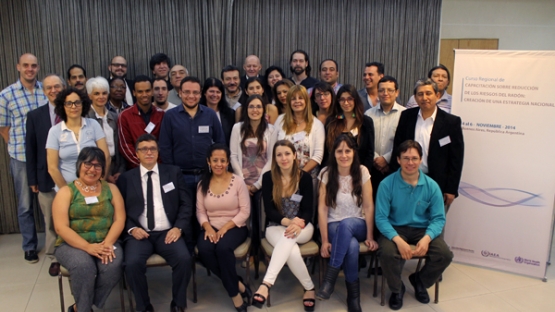First discovered in 1899, radon is a naturally occurring radioactive gas produced from the natural decay of uranium and thorium, which are found in rock and soil in varying concentrations around the world. Outdoor concentrations of radon are normally low and of little radiological concern. However, the gas can sometimes accumulate to high concentrations indoors, depending on local geological conditions, the climate and building construction practices.
A regional technical cooperation (TC) project1 to strengthen national infrastructure for compliance with regulations and radiological protection requirements has started this year, focusing on strengthening radiation protection programmes in medical and occupational exposure in the Latin America region. As part of the project, a regional training course on 'Reducing the Risks from Indoor and Occupational Exposure to Radon: Establishing a National Radon Strategy' was organized in cooperation with the World Health Organization and hosted by the Nuclear Regulatory Authority in Buenos Aires, Argentina, from 4 to 6 November 2014. Twenty-eight participants from regulatory bodies, research centres and Ministries of Health from 14 Member States (Argentina, Bolivia, Brazil, Cuba, Dominican Republic, Ecuador, Guatemala, Jamaica, Mexico, Nicaragua, Paraguay, Peru, Uruguay and Venezuela) participated.
The course was based on the IAEA safety standards, specifically, the requirements in the International Basic Safety Standards and the supporting guidance relating to the control of radon at home and at work. The epidemiological evidence of health risks from long term exposure to radon for both workers and the public was discussed during the course. The attendees also heard presentations on techniques for measuring radon, on the control of occupational exposure in uranium mines and in naturally occurring radioactive material (NORM) industries, and on the design of a national action plan for radon in homes and natural radioactivity in drinking water.
From the discussions, it is clear that there is considerable interest in the region in developing programmes to measure, and where necessary control, exposure radon in both occupational and domestic settings. In many cases, national legislation does not assign responsibilities for the control of exposure to radon apart from that occurring in uranium mines. This effectively prevents the regulatory body from taking any action, including the first step of measuring exposure.
In the case of radon in homes, limited studies have been undertaken in many countries in the Latin America region. While some do not appear to have a serious problem, other countries have already identified regions with elevated concentrations. An important observation made during the training course is that the very high individual radon concentrations sometimes observed in homes in many European countries does not seem to be replicated in Latin America. However, although extreme values may be absent, for many people radon is still the main source of their radiation exposure and represents an important public health risk. More data is needed before firm conclusions can be drawn. An important task will be for national authorities to produce statistically valid data that does not focus solely on high-risk areas.
Participants at the course agreed that improvements to equipment, resources and legal responsibility are necessary. Further regional training courses and expert missions on this subject matter are planned in 2015 as part of the IAEA's technical cooperation activities under this project.
1. RLA/9/075, 'Strengthening National Infrastructure for End-Users to Comply with Regulations and Radiological Protection Requirements'.


